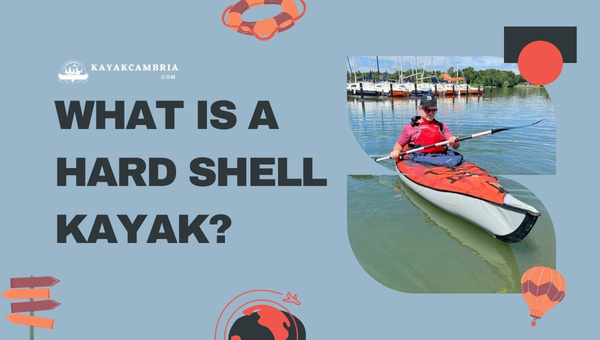Kayak selection depends on individual preferences and use. It’s important to consider size, weight, portability, and durability. There are many types of kayaks available, and each one offers different benefits.
In this blog post, we’ll discuss the two main types of kayaks: inflatable and hard shell, and help you in deciding which kayak is better for you: Inflatable kayak or Hard Shell? Before you make a purchase, it’s important to have a clear idea of what you’re looking for so that you can make an informed decision and choose the one that best suits your needs.
Contents
Contents
What Is An Inflatable Kayak?
Inflatable kayaks are made from PVC or vinyl fabric, which is lightweight and easy to transport. They fold down into a compact package for storage and can be inflated with an air pump in just a few minutes. Inflatable kayaks have several advantages over other types of kayaks, including affordability and portability.

They are also very durable, often able to take a good deal of abuse before they need to be replaced. It’s important to note that the quality and type of fabric used in an inflatable kayak will affect its performance, so be sure to choose one with a good reputation.
Advantages of an Inflatable Kayak:
- Inflatable kayaks are lightweight and easy to transport.
- They fold down into a compact size for storage when not in use.
- Inflatables are generally more stable than hardshell kayaks, making them ideal for beginner paddlers.
- The thicker material used makes the ride softer and more comfortable.
- Inflatables are generally more durable and puncture resistant.
- They are less likely to cause injury if the boat is overturned.
Disadvantages of an Inflatable Kayak:
- They are not as fast or efficient in the water as hardshell kayaks.
- The quality of the material used will affect the performance of an inflatable kayak, so it’s important to choose one with a good reputation.
- Inflatable kayaks need to be inflated and deflated regularly, which can be time-consuming.
- Not a lot of extra legroom if two people are in it.
- Harder to control due to their buoyancy and lack of rigidity.
What Is A Hard Shell Kayak?
A hard shell kayak is a rigid, molded boat made from fiberglass, plastic, or wood. This type of kayak is often preferred by experienced paddlers due to its performance and maneuverability in the water. Hard shell kayaks are generally more efficient and faster than inflatable kayaks, but they can also be more expensive and less portable.

Advantages of a Hard Shell Kayak:
- Higher performance in the water.
- More durable than inflatables.
- Better for experienced paddlers due to its speed and maneuverability.
- Efficient and faster than inflatables.
- Can handle rougher water conditions.
Disadvantages of a Hard Shell Kayak:
- Can be more expensive than inflatable kayaks.
- Generally heavier and less portable than inflatables.
- Require greater storage space.
- May require regular maintenance for optimal performance.
Inflatable Kayak Vs Hard Shell Kayak: Which is Better?
When it comes to selecting the right kayak, there isn’t an easy answer. It all depends on your skill level, budget, and intended use. We will discuss the pros and cons of both types, so you can make an informed decision about which is best for your needs.

1. Performance
Hard shell kayaks are designed for better performance in the water, whereas inflatable models are more suitable for beginners and recreational paddlers. Hard shell kayaks are generally faster, more efficient, and have greater maneuverability in the water. Inflatable kayaks are often slower and not as efficient, but they can still be fast enough for recreational paddling.
Both types are capable of handling rougher water conditions. Hard shell kayaks will handle slightly better in these conditions than inflatables. So if you are looking for the best performance, a hard shell kayak is likely to be your best option.
2. Portability and Storage
Inflatables are the clear winner when it comes to portability and storage. They fold down into a compact size that can fit in most cars, boats, or even backpacks. Hardshell kayaks tend to be bulky and require more space for transport and storage.
Both types of kayaks need to be stored in a dry place, however, hard-shell kayaks require more space than inflatable models. Inflatable kayaks can often be stored in less space due to their foldable or collapsible design. It is important to consider the available storage space when deciding which type of kayak is right for you.
3. Price
The price difference between hard shell and inflatable kayaks can vary significantly. Generally, hard shell kayaks will be more expensive than inflatables due to the performance advantages and materials used in their construction. However, you can find quality inflatable models at a reasonable price that are just as durable and perform well in the water.
Both types of kayaks vary widely in price and can range from very affordable to high-end. It is important to consider your budget when shopping for a kayak, as well as the intended use. If you are looking for an affordable recreational kayak, an inflatable model may be the better option.
4. Durability
Inflatables and hard shell kayak both provide a durable and reliable platform for paddling. However, hard shell kayaks tend to be more robust in rough water conditions than inflatables and less prone to damage. Inflatable kayaks are made from heavy-duty materials and are designed to be puncture resistant.
However, the durability of hard-shell kayaks is dependent on the material used in their construction and can be compromised if not cared for properly. Inflatable kayaks, on the other hand, are usually more durable and depend largely on price and purpose. As long as you don’t go cheap, inflatable kayaks can be just as durable as hard shells.
5. Maintenance
Hard shell kayaks require regular maintenance for optimal performance. This includes cleaning, checking for signs of wear and tear, and lubricating moving parts. Inflatables generally don’t require much in terms of maintenance, but it is still important to inspect them regularly to ensure they are performing correctly.
Inflatable kayaks may require patches or valve replacement over time, but this is less frequent. The main drawback to inflatables is that they need to be stored in a dry place when not in use, otherwise the fabric could become moldy or mildewed. So, both kayaks require regular maintenance, and you must decide which is best for your needs.
6. Weight and Capacity
The weight and capacity of a kayak will depend on the size and type. Generally, hard shell kayaks are heavier but can often take an additional person or gear. Inflatables are lightweight but can be difficult to transport if you plan on going a long distance.
On the other hand, inflatable kayaks are lighter but have a higher load capacity. Inflatable kayaks have the edge when it comes to carrying two people, or if you need to transport extra gear. So, if you’re looking for more capacity then an inflatable model might be the better option.
7. Comfort
Comfort is a key factor to consider when choosing the right kayak. Both inflatable and hard shell kayaks can provide a comfortable ride. Inflatable models feature wide, foam-filled seats that offer excellent support while paddling. Hard shell kayaks often have adjustable padded seats for better support and comfort.
Sitting on a hard surface for hours can be tough on your back, so if you want the most comfortable seat then an inflatable kayak might be the better choice. On the other hand, inflatable seats won’t provide much back support if required, so if this is a priority, then hard shell kayaks are the better option.
8. Control and Stability
Inflatable and hard shell kayaks both offer good control when paddling. The type of kayak you choose will depend on your preference, as well as the conditions you plan to paddle in. Hard Shell kayaks are typically more stable in rough waters, while inflatable models provide better maneuverability in tight spaces or shallow waters.
The materials used in construction can also affect the control of a kayak. Hard shells are typically made from strong rigid materials, while inflatables are constructed with heavy-duty fabrics and multiple air chambers for improved stability.
9. Safety
Safety should be a top priority when selecting any type of kayak. Both hard shell and inflatable kayaks are designed with safety features such as grab handles, adjustable foot braces, and buoyancy aids. However, it is important to remember that each type has its own unique pros and cons when it comes to safety.
Hardshell kayaks tend to be more stable in rough waters, while inflatable models may provide better maneuverability in tight spaces or shallow waters. Additionally, hard shells generally have sealed bulkheads that can help keep water out of the cockpit should the kayak become flooded. Inflatable kayaks tend to be more prone to punctures and leaks, so it is important to check for signs of wear and tear before use.
10. Construction
The construction of the kayak should also be taken into consideration. Hard shell kayaks are typically constructed from strong rigid materials such as wood, plastic, fiberglass, and composite materials. This makes them heavier but able to withstand more punishment in rough conditions.
Inflatable models are usually lighter and made from synthetic rubber and plastic polymers. While they are often more lightweight, they may not be as durable in the long run.
Overall, both hard shell and inflatable kayaks offer a great way to enjoy the outdoors. Depending on your preferences and needs, either type can provide an excellent paddling experience. No matter which one you choose, it is important to make sure that you select a kayak that fits your size, type, and skill level.
Our Review: Which One Is Better?
Ultimately, the choice of which kayak is better for you will depend on your needs and preferences. Hard Shell kayaks are generally more durable and offer good stability in rough waters, while inflatable models provide a lighter option with increased maneuverability.

It is also important to consider safety features, as well as weight and capacity when making your decision. No matter which types you choose, with the right equipment and preparation, your time on the water will be a success.
No one kayak is right for everyone, so take some time to research and compare different models before making your purchase.
Frequently Asked Questions
1. Which kayak is better, inflatable or hard?
The choice of which kayak is better for you will depend on your needs and preferences. Hard Shell kayaks are generally more durable and offer good stability in rough waters, while inflatable models provide a lighter option with increased maneuverability.
2. Are inflatable kayaks as good as hard kayaks?
Inflatables offer increased portability and affordability, but may not perform as well in choppy or rough waters. They are suitable for recreational use, but experienced paddlers may prefer a hard-shell kayak for better performance.
3. Which kayak is good for beginners?
Inflatables can be great for beginner kayakers due to their affordability and portability. They may not offer the same performance as hard shell kayaks, but they can still be used to enjoy recreational paddling and explore waterways.
4. What is the best way to store a kayak?
Kayaks should be stored in a cool and dry location away from direct sunlight. If possible, store them off of the ground or in a cover to reduce the amount of dirt, dust, and other debris that can accumulate over time. Also, make sure to rinse and dry the kayak after each paddling session. This will help keep it clean and free from corrosion.
5. Are kayaks easy to transport?
Yes, most inflatable and hard shell kayaks are designed for portability and can easily be transported to a nearby launch site or stored away in a home storage unit. Depending on the size of your kayak, you may also want to invest in specialized racks and carriers to help keep it secure while in transit.
Final words
In this blog post we tried to help you decide which kayak is best for you – be it an inflatable kayak or hard shell. We hope that we were able to provide you with the information necessary to make an informed decision. No matter which type of kayak you choose, we wish you a safe and enjoyable time out on the open waters!

